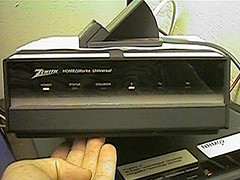
- Image by lerxst / boycat via Flickr
Recently, the excess of computer wires hooking together our systems and unsuccessful attempts to get them into order frustrated us.
So, with a significant investment of time, and the cost of some organizational tools, ie some new cables, cable tacks, velcro ties, etc., we’re going to try and tackle this issue.
Our first plan involves a redo of our networking appliances. That includes the DSL/cable modem, the router, and a gigabit switch. All these items belong together, as they all serve to form the house network. But currently, they terminate behind and under a desk in an ugly mess.
In comes our current love affair with Swedish furniture. It isn’t too expensive, and it looks decent for the price we can afford. We recently replaced some old bookshelves with some Billy Bookshelves from Ikea, nice because of three features: a curve at the bottom allowing the shelves to press flat on the wall without removing the baseboard, the fact the backing slides into a groove to hold it in place, rather than merely being nailed, and the fact that you can buy height extensions and build your bookcases up to the ceiling.
For the first stage of our project, we decided to build in inobtrusive network wiring rack into an endtable. Endtables are nice in that they are small. We were concerned about ventilation, so we ended up planning on using an Eina table, designed as a side table for a bed. It is made of particleboard, but it is thick and stable. The item offers optional casters for rolling around. Importantly for us, it is open on both sides.
We haven’t yet finished preplanning for this reconstruction, as we attribute our failure to succeed in organization projects like this in the past due to lack of preplanning. But our plan is to install the equipment and place the item under our large computer desk, as many people place rolling filing cabinets, with the wood face facing outward, as opposed to what would be seen normally, the open faced sides. This only leaning down will allow the components to be seen.
All cables will be tied and secured to the cart in such a way the cart can easily be disconnected and moved for cleaning and maintenance. The room where these cables are located borders another room that needs network access, so we’ve built an in-wall patch panel. It is a simple project. Two keystone wallplates with network jacks on them connected by a short piece of wire, so a wire plugged into identical jacks on each side will act as a single coupled-together wire. Since keystone jacks are modular, we can add extra cables, network or otherwise, as needed.
The patch jack, we should probably call it, sits behind the table under the desk. And we plan to put all of the wires going into it from the network table into some flexible split-loom tubing, which will further hide it, giving it a more professional feel, although it does admittedly limit redesign, as removing the cables from the tubing is an annoyance…which is why pre-planning is so important.
We’ll update you on this with pictures as it develops. Also on the design block, a bedroom HTPC installation plan designed to do some of the same thing.


![Reblog this post [with Zemanta]](http://img.zemanta.com/reblog_e.png?x-id=d4507010-751a-4f7a-99a0-650ac4ddb9cc)